Back in 2014, we struggled to fill out our top 10 roundup of Linux-based robots and padded the list with conceptually similar autonomous underwater vehicles (AUVs) and unmanned aerial vehicles (UAVs). In addition, many of those robots were proprietary or open source only on the software side. Today, however, it’s easy to fill out a top 10 list of Linux-based terrestrial robots that are open source in both software and hardware. In fact, we were forced to leave a number of worthy projects waiting in the wings.
The latest open source Linux robot to hit the scene — the Turtle Rover — won funding on Indiegogo only last week. This four-wheeled bot, which is larger and more sophisticated than typical wheeled robots like the popular, dual-wheeled GoPiGo, was designed to mimic Martian rovers. Another major player here is the recently rev’d, dual-wheeled TurtleBot 3.
Like most of our entries, these models are wheeled robots built around the Raspberry Pi. With the advent of the quad-core, WiFi-enabled RPi 3 model, we’ve seen far more advanced, and sometimes semi-autonomous Pi-based robots, in addition to the numerous RPi-based toy designs of recent years. Other SBCs have also inspired robot designs, especially the BeagleBone and BeagleBone Blue, which is especially suitable for robotics projects.
While open source hacker boards have expanded Linux robot development in recent years, a larger influence is the optimization of Linux platforms such as Ubuntu for interaction with the open source Robot Operating System (ROS) middleware. A number of our top 10 robots include ROS integration.
Combined with open Linux software, the availability of open source hardware schematics and 3D CAD designs means that users create many of their own parts with 3D printers. More importantly, open hardware also means that the stated specs and capabilities are only a starting point. For example, there’s a fair amount of truth to Switch Science’s claims that its Rapiro robot’s “limitless possibilities all depend on you.” Certainly, there are limitations on all these robots based on the compute board and components, but the potential for creativity is much greater than with proprietary bots with the same base feature set.
Many of these systems, such as the Hicat Livera Robot Kit, combine a Linux computer with an Arduino board for motor control. Others use their own MCU-based chips for motor control.
Terrestrial robots come in a wide variety of form factors. In addition to typical wheeled robots, which are essentially remote-controlled or semi-autonomous toy cars, there are stationary bots such as the FarmBot Genesis. We did not include any of the numerous, Pi-based, one-armed picker robots, such as the worthy MeArm Pi.
Industrial one- and two-armed mobile manipulation robots that run Linux include the Rethink Robotics’ Sawyer and similarly $30,000 and up Kuka YouBot. The YouBot offers more open software, but will soon be discontinued. Fetch Robotics appears to be selling its Linux-based, industrial manipulation robot, which features open software, but only as an OEM product packaged with services. None of these offer open hardware, however.
There are several interesting rolling service robots that run Linux such as Savioke’s Relay, the follow-on the SaviOne model that made our last roundup. There are also several tuxified telepresence robots for mobile videoconferencing such as the Suitable Technologies Beam and BeamPro. None that we know of are open source, however.
At the lowest level of mobility, we’ve included the Q.bo One, which is limited to rotating its spherical head to talk directly to humans. The Q.bo One is a member of a new pack of AI-infused social robots, including the long delayed Jibo, a stationary bot with a swivel head that recently launched in an early access program. Other conversational robots that roll around on wheels, but are built with a humanoid form factors include the Linux-based Pepper from Softbank and Aldeberan and the new Android-based iPal from AvatarMind.
Unlike the Q.bo One, these social robots lack open source hardware, and their software platforms are only partially open. They’re worth tracking, however, since they represent the cutting edge of robot AI.
On the opposite end of the movement spectrum, we have included two ambulatory, highly articulated bipedal humanoid robots. On the low end, there’s the Rapiro and on the high-end, the Odroid-XU4 based Poppy Humanoid, which has 25 Degrees of Freedom (DoF) movement, but starts at over $7,000.
Top 10 Robots
We have omitted the many open source robotics projects and products that run only on Arduino. (Learn Robotics has published a list of open source robot projects of all types.) Finally, there are many intriguing academic robots like the Poppy that run Linux, but are not easily available to the general public. Like Poppy, some of these may expand into wider availability.
The following is a list of 10 intriguing Linux terrestrial robots with open source hardware and software. Most are available in both kit or finished form.

Erle Robotics is primarily known for its open source drones, but its terrestrial Erle-Rover runs Debian and ROS on the same Raspberry Pi 3 based Erle-Brain 3 computer that powers its Erle-Copter.
This four-wheeled rover measures 465x325x145mm, and ships with a quad-channel, 2.4GHz remote RC controller and a 1600 mAh battery. Options include an 8-megapixel HD camera, GPS and WiFi modules, and a 2 km range RF telemetry link. Tutorials are provided for adding obstacle avoidance.
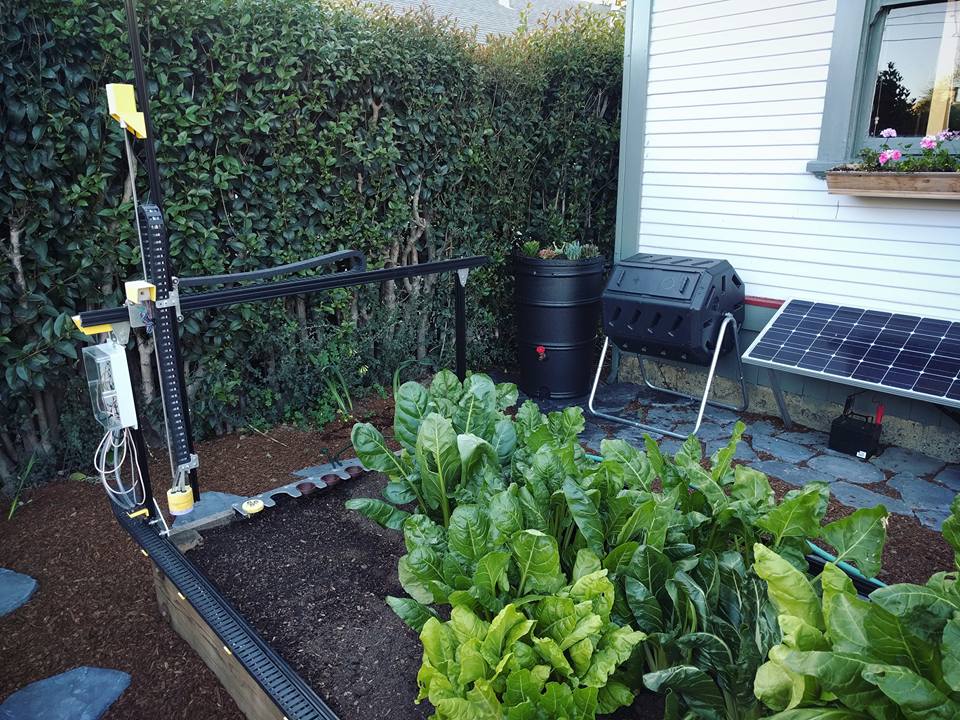
If you’re looking into automated watering systems for your garden, there are plenty of Linux- (and RPi-) based options available, but the FarmBot Genesis kit goes several steps further than most. This CNC-style precision farming robot can also seed, weed, and fertilize. Powered by a Raspberry Pi 3 and Arduino based Farmduino v1.0 microcontroller with four DRV8825 stepper drivers, the robot is suspended over an up to 20 sq. meter raised garden. Its gardening arm rolls on tracks for precise location, and extends down into the garden with custom attachments, including sensor devices. Web-based software lets you plan your garden with proper spacing and scheduled maintenance.
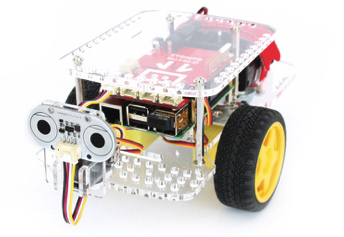
Billed as the “world’s best selling Raspberry Pi robot,” the dual-wheeled GoPiGo kit is focused on STEM education. The AA battery powered bot was recently rev’d to a third-gen model that offers improved durability and motor control. Its RedBoard motor control board has been upgraded with more sensors, including 2x analog/digital, 2x I2C, and a serial port. If you bring your own WiFi-enabled RPi 3 to the table, the GoPiGo3 is also faster and more capable than earlier models. With older Pi models, you can plug in a USB WiFi dongle to control the bot, and any model can attach the official Raspberry Pi camera module, as well as Lego Technic parts. The robot is available with a Debian-based DexterOS distro plus Dexter’s Blockly based Bloxter drag-and-drop software. Dexter also offers a separate “BrickPi” RPi-ready platform that features Lego expansion.
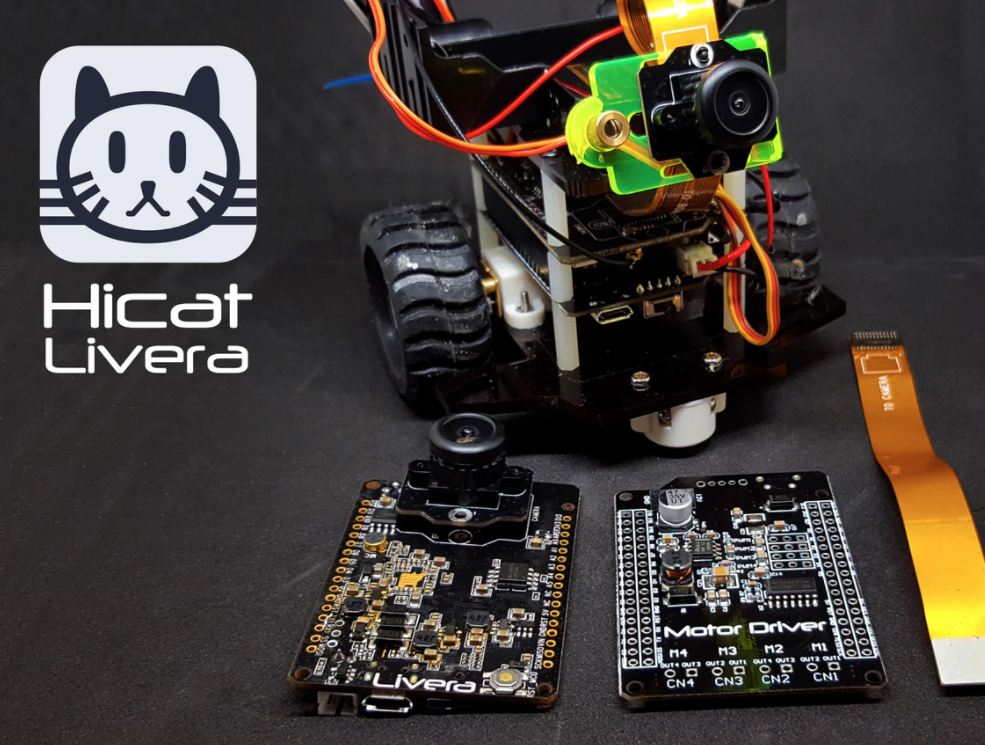
Hicat’s Livera Robot Kit is built on its $49 Livera machine vision SBC, which runs Linux on an ARM9 HiSilicon Hi3518 camera SoC, There’s also an Arduino-driven Atmel 32u4 MCU and a MediaTek MT701 WiFi chip. The SBC provides an extension shield with a microSD slot, microphone, and speaker. The modest two-wheeled robot is focused entirely on the Livera board’s 720p ready camera with 140-degree viewing angle. APIs provide streaming and photo processing, as well as OpenCV enabled color sensitivity and object tracking. There’s also a separate Arduino library and NodeJS support.
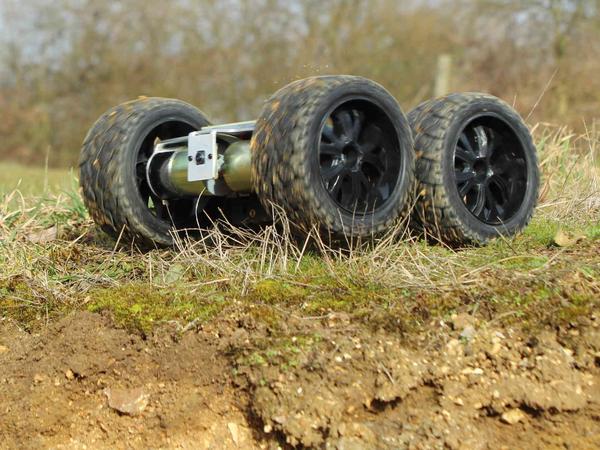
The six-wheeled DiddyBorg was billed as the “most powerful Raspberry Pi robot available,” but is now out of stock. PiBorg has replaced it with a similar, but four-wheeled, MonsterBorg that appears to be equally tough. Unlike the DiddyBorg, the MonsterBorg requires no soldering. The MonsterBorg can be programmed as a self-driving robot or “or raced around the garden as an RC off-roader,” says PiBorg. It’s also the primary racing robot for the Formula Pi race series. The RPi based kit lets you build a bot that can run for up to three hours on 10x AA batteries. The kit includes a ThunderBorg 5A motor controller and 4x 300 RPM Zhengke 37mm motors that drive 105mm diameter off-road wheels. You supply the Pi of your choice, as well as options such as a Pi camera. The MonsterBorg recently shipped to Kickstarter backers, and you can sign up for notifications about the upcoming retail launch. PiBorg has also launched a Bluetooth controlled, trackwheel BOB robot that runs on a Rasberry Pi Zero W.

The humanoid, bipedal Poppy Humanoid runs Ubuntu 14.04 on an octa-core Odroid-XU4 SBC and is designed for researchers, educators, and artists. The kit includes Robotis Dynamixel servomotors and 3D printed parts. Fully assembled, Poppy Humanoid is an 83cm tall ambulatory robot with 25-DoF movement and a fully actuated vertebral column. The robot’s head features a 4.5-inch screen, and there’s an HD camera with a large FoV. French robotics firm Generation Robots also sells an Odroid-XU4-driven, 5,300 Euro ($6,283) Poppy Torso model with Poppy’s arms and hands, but no legs. There’s also a simple, 319 Euro ($378) Ergo Jr. bot that consists of a single arm and gripper controlled by a Raspberry Pi. Like the Poppy Humanoid, they are fully open source.

The swiveling, slightly humanoid head is the only thing that moves on the tabletop Q.Bo One computer, but there’s a lot more going on inside than the whirring of its Dynamixel servos. The Q.bo One can recognize faces and track movements, and can converse using natural language processing. The robot runs Linux on a Raspberry Pi 3 and Arduino code on an Atmel ATSAMD21 MCU. The Raspbian software uses OpenCV for vision processing, and can be programmed with Scratch, C++, and more. There are also hooks to IBM Bluemix, NodeRED, and ROS. Hardware features include a speaker, 3x microphones, touch sensors, and an LED matrix that creates an expressive mouth.

The humanoid, bipedal Rapiro may look like Buzz Lightyear’s loyal sidekick, but the Amazon shopping page clearly states “This is NOT a toy.” (Aw, Mom…) The Rapiro ships with a control board that can be programmed out of the box via the micro-USB port using the Arduino IDE. If you add a Raspberry Pi, you can give Rapiro additional sensors, WiFi and Bluetooth control, and a camera with image recognition capabilities. The 250x200x155mm robot has 12 servos that provide movement to the neck, waist, arms, and feet. Rapiro can walk and dance, and its dual grippers can pick up light objects. The robot can even be programmed to sweep your desk or grip a pencil and type on a keyboard. LEDs light up to create facial expressions.
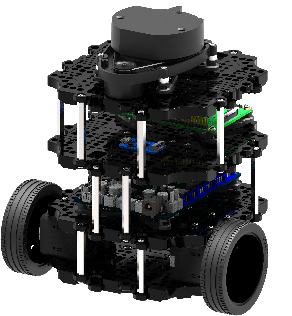
The third-gen, Ubuntu/ROS-based TurtleBot switches to a new manufacturer (Robotis), but the community is still guided by Open Robotics, a wing of the Open Source Robotics Foundation (OSRF). The dual-wheeled TurtleBot3 is “the most affordable robot among the SLAM-able mobile robots equipped with a general 360-degree LiDAR,” says Open Robotics. The TurtleBot3 was launched in June with a choice of Raspberry Pi 3 or Intel Joule based compute boards for Burger and Waffle models, respectively. Since then, Intel discontinued the Joule, but no long-term replacement has been announced for the larger Waffle, which sells for $1,799 including the Joule and Intel’s RealSense depth-finding camera. The $549 Burger lacks a RealSense, but similarly integrates a 360-degree HLS-LFCD LDS planar LiDAR system, enabling autonomous navigation with the help of SLAM (simultaneous localization and mapping) algorithms. Both models feature a Robotis OpenCR board for controlling the Dynamixel servos, as well as touch, IR, color, and IMU sensors. The board can run Arduino on its 216MHz, 32-bit Cortex-M7 STM32F7 MCU. An 1800mAh battery and numerous interfaces are also available.
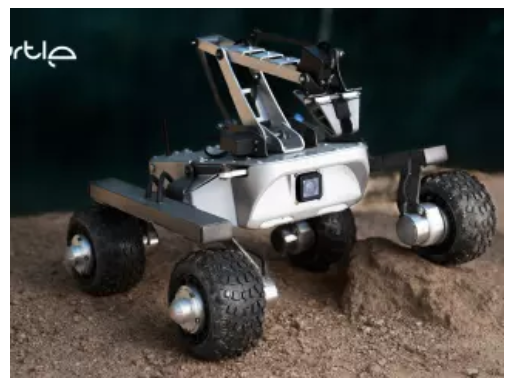
The four-wheel Turtle Rover adopts the basic form factor of a Martian Rover. Built around a Raspberry Pi 3, the robot features a 2-megapixel, fisheye lens HD camera and up to four-hour battery life. There’s no autonomous functionality at this point, but you can remote-control the bot within a 200-meter WiFi range. The waterproof, 460x410x270mm Turtle Rover is bigger than most Pi-based wheeled robots, but can still be carried on a backpack. It includes a 2-DoF arm with gripper that can lift 500 grams, and the robot can carry a 5 Kg payload. The $999 kit lacks the RPi 3, battery, antenna, and some other components, some of which can be 3D printed. The $1,972 kit is fully assembled. You can still order one on Indiegogo for an April or June 2018 delivery.
Learn more about embedded Linux at the upcoming Embedded Linux Conference in Prague. Linux.com readers receive an additional $40 off with code OSSEULDC20. Register Now!





